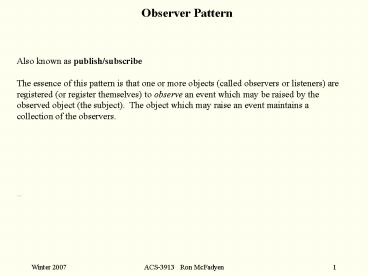Observer Pattern - PowerPoint PPT Presentation
1 / 10
Title:
Observer Pattern
Description:
The essence of this pattern is that one or more objects (called observers or ... The Observer Pattern defines a one to many dependency between objects so that ... – PowerPoint PPT presentation
Number of Views:157
Avg rating:3.0/5.0
Title: Observer Pattern
1
Observer Pattern
Also known as publish/subscribe The essence of
this pattern is that one or more objects (called
observers or listeners) are registered (or
register themselves) to observe an event which
may be raised by the observed object (the
subject). The object which may raise an event
maintains a collection of the observers.
2
Observer Pattern
Problem There are many objects (observers /
subscribers) needing to know of the state
changes, or events, of another object (subject /
publisher), and we want to keep the coupling
low. Solution The object that is responsible
for the event is given the responsibility of
monitoring for the event this object is the
subject. Objects that are interested in the event
must register with the subject as interested
parties as observers. The subject will notify
its observers when the event occurs.
3
Observer Pattern
The Observer Pattern defines a one to many
dependency between objects so that when one
object changes state, all its dependents are
notified automatically
Observer objects that want to be notified of a
certain event. An observer must have an update
method whereby it is notified of an
event. Subject the object that triggers the
event. It must implement attach (observer) - add
an observer to its list of observers detach
(observer) - remove an observer from notify ()
- goes through its list of observers calling each
observers update method As needed - additional
methods to allow an observer to get additional
information
4
Interfaces
interface Subject
interface Observer
attach() detach() notify()
update()
5
Generic pattern
interface Subject
interface Observer
attach() detach() notify()
update()
ConcreteObserver
ConcreteSubject
update()
attach() detach() notify()
6
Generic pattern
The subject may have many observers. Their types
are not known. They are only known as objects
that implement the observer interface. Subjects
and observers are loosely coupled.
The subject will send each observer the update()
message when the event occurs.
interface Subject
interface Observer
attach() detach() notify()
update()
The observer knows the subject and registers with
that object using the attach() message.
ConcreteObserver
ConcreteSubject
update()
attach() detach() notify()
7
Weather Station Example
interface DisplayElement
interface Subject
interface Observer
display()
attach() detach() notify()
update()
CurrentConditionsDisplayupdate() display()
StatisticsDisplayupdate() display()
ForecastDisplayupdate() display()
WeatherData attach() detach() notify()
The class diagram
8
Weather Station Example
interface DisplayElement
interface Subject
interface Observer
display()
attach() detach() notify()
update()
observer
subject
Observer
Concrete observer
Concrete observer
Concrete observer
CurrentConditionsDisplayupdate() display()
StatisticsDisplayupdate() display()
ForecastDisplayupdate() display()
Concrete subject
WeatherData attach() detach() notify()
This class diagram has an adornment, a
collaboration, that shows the applications
participants in the pattern
9
Weather Station Example
- Consider the text example.
- Examine the code to ensure you understand how the
observer pattern is implemented. - Why is there a DisplayElement interface?
- Suppose you are a developer and there is a
requirement for a new type of observer (e.g. heat
index display) - What must you change in the existing code?
- What classes must you write?
- Draw sequence diagrams to illustrate behaviour.
What messages are sent - When an object registers?
- When an object unregisters?
- When the event of interest occurs?
10
Weather Station Example
- Java consider the Observable class and the
Observer interface. - http//java.sun.com/j2se/1.5.0/docs/api/java/util/
Observable.html - http//java.sun.com/j2se/1.5.0/docs/api/java/util/
Observer.html - How do we rewrite our weather station example to
use these features of Java? - What are the advantages/disadvantages of this
approach? - Java consider the ActionListener interface.
- http//java.sun.com/j2se/1.5.0/docs/api/java/awt/e
vent/ActionListener.html - How do we rewrite our weather station example to
use these features of Java? - What are the advantages/disadvantages of this
approach? - Observable http//java.sun.com/j2se/1.5.0/docs/ap
i/java/util/Observable.html - Observer http//java.sun.com/j2se/1.5.0/docs/api/
java/util/Observer.html - ActionListener http//java.sun.com/j2se/1.5.0/doc
s/api/java/awt/event/ActionListener.html

